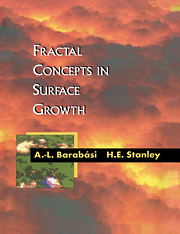Book contents
- Frontmatter
- Contents
- Preface
- Notation guide
- PART 1 Introduction
- PART 2 Nonequilibrium roughening
- PART 3 Interfaces in random media
- PART 4 Molecular beam epitaxy
- 12 Basic phenomena of MBE
- 13 Linear theory of MBE
- 14 Nonlinear theory for MBE
- 15 Discrete models for MBE
- 16 MBE experiments
- 17 Submonolayer deposition
- 18 The roughening transition
- 19 Nonlocal growth models
- 20 Diffusion bias
- PART 5 Noise
- PART 6 Advanced topics
- PART 7 Finale
- APPENDIX A Numerical recipes
- APPENDIX B Dynamic renormalization group
- APPENDIX C Hamiltonian description
- Bibliography
- Index
17 - Submonolayer deposition
Published online by Cambridge University Press: 23 December 2009
- Frontmatter
- Contents
- Preface
- Notation guide
- PART 1 Introduction
- PART 2 Nonequilibrium roughening
- PART 3 Interfaces in random media
- PART 4 Molecular beam epitaxy
- 12 Basic phenomena of MBE
- 13 Linear theory of MBE
- 14 Nonlinear theory for MBE
- 15 Discrete models for MBE
- 16 MBE experiments
- 17 Submonolayer deposition
- 18 The roughening transition
- 19 Nonlocal growth models
- 20 Diffusion bias
- PART 5 Noise
- PART 6 Advanced topics
- PART 7 Finale
- APPENDIX A Numerical recipes
- APPENDIX B Dynamic renormalization group
- APPENDIX C Hamiltonian description
- Bibliography
- Index
Summary
The main focus of our previous discussion of MBE has been the identification of various universality classes. The models we discussed are expected to be valid on a coarse-grained level, at which the exact structure and form of an island does not matter. However, with the perfection of experimental tools, it is possible to observe the interface morphology at the atomic scale – leading to the discovery of rich island morphologies. In this chapter we focus on this early-time morphology, for which the coverage is less than one monolayer; this regime is usually referred to as submonolayer epitaxy.
The phenomenology is quite simple. Start with a flat interface, and deposit atoms with a constant flux. The deposited atoms diffuse on the surface until they meet another atom or the edge of an island, whereupon they stick. Thus if at a given moment we would photograph the surface, we would observe a number of clusters – called islands – with monomers diffusing between them. What is the typical size and number of the islands? What is their morphology? How do these quantities change with the coverage and with the flux? These are among the questions we address.
Model
Let us consider in more detail the deposition process outlined above. Consider a perfectly flat crystal surface with no atoms on it. At time zero we begin to deposit atoms with a constant flux F. Atoms arrive on the surface and diffuse (the deposition and diffusion processes take place simultaneously).
- Type
- Chapter
- Information
- Fractal Concepts in Surface Growth , pp. 175 - 191Publisher: Cambridge University PressPrint publication year: 1995
- 1
- Cited by



